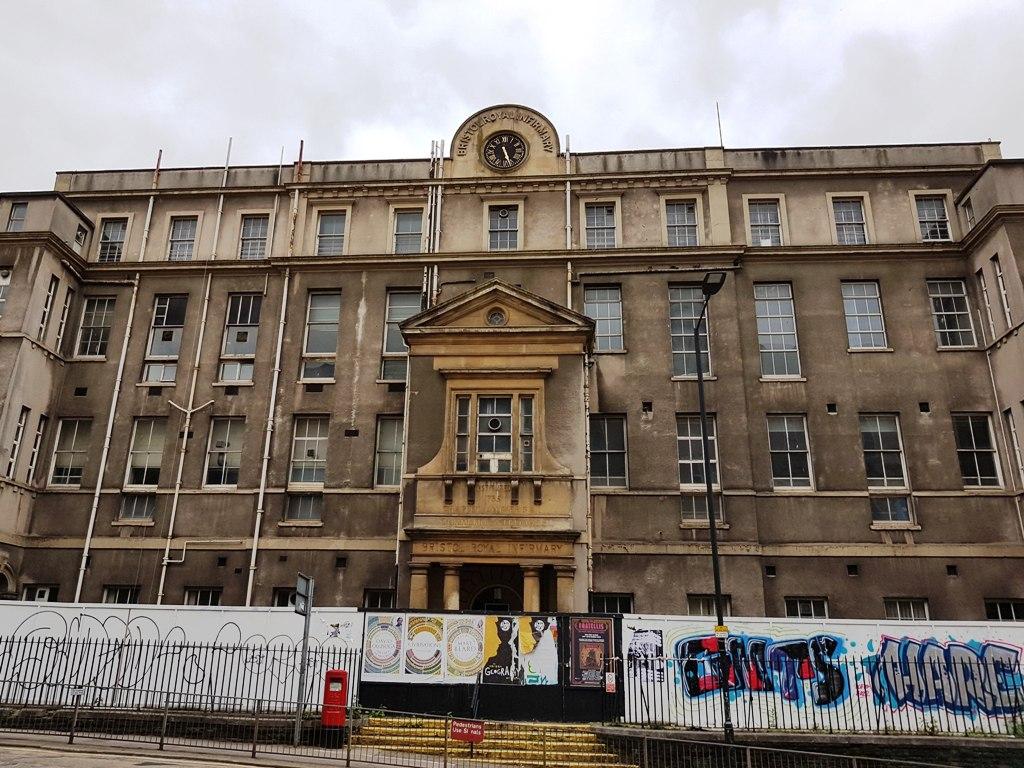The Old Bristol Royal Infirmary building – Charity Universal
Historic England have two assessments to make in parallel. An application to list the building and an application from Unite Students for a Certificate of Immunity from listing. This was the Society’s response.
National listing history
The Society is aware that two applications (2010 and 2015) were made to Historic England (formerly English Heritage) that the buildings be listed but both were declined. Despite an earlier refusal Historic England recommended listing the later (1858-60) mortuary chapel with Grade II status in 2017. The Society submits that there are good reasons to list the Charity Universal Building, which should attract a similar protected status as, “A building identified as having a degree of significance meriting consideration in planning decisions, because of its heritage interest.”
The Charity Universal Building
The Listing Advisor will be familiar with the building. This submission refers only to the building’s exterior and its significance to the public realm; it excludes the Lower Maudlin Street extension. We have not had access to the interior and assume that later interventions have largely removed the original interior fabric.
The principles to be applied by the Secretary of State when deciding whether a building is of special architectural or historic interest.
Age and rarity
The Bristol Royal Infirmary is one of the earliest hospitals founded in the country outside of London (1736) though the Old Building on the site dates from a later period (1784-1814). The architect was Thomas Paty, a distinguished Bristol architect. The Charity Universal Building was complete before 1840. The Charity Universal Building has special interest. The Georgian foundation hospital was an amazing achievement; it was one of the first four charity hospital to open in Britain. The only older hospitals were Adenbrooks Cambridge (1760), Winchester (1736) and Edinburgh (1738).
Aesthetic merits – its intrinsic architectural merit
Despite later interventions, the 18th century elevation and forecourt remain a substantial and distinguished element in the street scape. The Charity Universal Building is articulated into a central block with recessed bays that link the projecting wings to the centre. The horizontal hierarchy of the floors completes the Old Building’s visual logic. The façade articulates the whole width of the block into a vertical rhythm with a horizontal hierarchy. The proportions of the elevation, the aperture proportions, and the wall to void ratio create a harmonious ensemble. The removal of the clutter of pipes and other disposable additions would reinstate the hospital’s quality. The restoration of the lowered window cills and the repair of the mutilated plat bands would produce a substantial planning gain. The absence of the Charity Universal Building would cause substantial harm to the character of the ‘hospital zone’. The number of objections to the proposed demolition demonstrate that it is a source of civic pride. The current state of disrepair is not a relevant consideration.
Group value, historical and social significance
In addition to the external architectural quality, the Charity Universal Building forms a group with the later neighbouring hospitals to create a strong civic character which demonstrates the social and economic development of hospital building over 200 years. The elevation creates an interesting composition with Charles Holden’s strong King Edward VII Memorial Wing on the north side of Marlborough Street. The neighbouring Bristol Eye Hospital is Grade II listed. The Charity Universal Building contributes positively to the area’s character and identity, it creates local distinctiveness and is a critical feature in the streetscape.
Selectivity and the national interest
An important factor to support listing of the Charity Universal Building is that it was the fourth public hospital in Britain. The foundation and construction of these early hospitals was a remarkable step in the provision of medical care. The Charity Universal Building is an example of the introduction enlightenment principles into our national life; a revolutionary social movement that deserves recognition. Charity Universal is a representative and a significant example of a nationwide movement and it makes a major contribution to the national historic stock.
Conclusion
The Society submits that earlier assessments of the Charity Universal Building concentrated overly on the loss of the original interior fabric. In the Society submission the critical factors for the listing assessment and which distinguish it from the earlier assessments are, (i) The quality of the external architecture and the contribution it makes to the streetscape and the group of civic buildings that create the Bristol central hospital zone. (ii) The national interest in the protection of a building that was a pioneer of universal health care. It assists the case for listing that the City Council’s independent panel recognised the architectural quality, streetscape value and the historic and social importance of the Charity Universal Building when they recommended it for local listing. Without listing, Bristol is certain to lose a 200-year old landmark civic building and a rare example of the national development the history of health care. It is important to retain the crucial aspects of the building, the original external fabric, the H-form plan, floor slabs and other notable features that contribute to the significance of the heritage asset.
John Frenkel
johnfrenkel@blueyonder.co.uk


It is also Bristol’s largest Georgian building and it survives. Larger in mass that the Corn Exchange and in plan
We have lost so much of Bristol’s heritage that it would be a tragedy if this building were demolished. The redevelopment of the General Hospital shows what can be achieved by a sensitive approach to change of use, without destroying the character of the area.